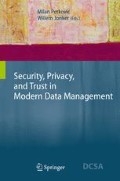Abstract
Radio-frequency identification (RFID) technology has become one of the most hotly debated ubiquitous computing technologies, and public fears of its alleged capability for comprehensive surveillance have prompted a flurry of research trying to alleviate such concerns. The following chapter aims at introducing and briefly evaluating the range of proposed technical RFID privacy solutions. It also attempts to put the problem of RFID privacy into the larger perspective of both applications and policy, in order to properly assess the feasibility of the discussed solutions.
Access this chapter
Tax calculation will be finalised at checkout
Purchases are for personal use only
Preview
Unable to display preview. Download preview PDF.
References
M.F. Relfe. When Your Money Fails. League of Prayer, Montgomery, AL, USA, January 1981.
S. Garfinkel and B. Rosenberg, editors. RFID: Applications, Security, and Privacy. Addison-Wesley, July 2005.
EPIC — Electronic Privacy Information Center. Radio frequency identification (RFID) systems. The A to Z’s of Privacy Website, 2006.
Capgemini. RFID and consumers-what European consumers think about radio frequency identification and the implications for business, February 2005.
S.A. Brown. Revolution at the Checkout Counter: The Explosion of the Bar Code. Wertheim Publications in Industrial Relations. Harvard University Press, Cambridge, MA, USA, 1997.
K. Finkenzeller. RFID Handbook: Fundamentals and Applications in Contactless Smart Cards and Identification. Wiley, 2003.
R. Want. RFID-a key to automating everything. Scientific American, 290(1):46–55, January 2004.
R. Want. The magic of RFID. ACM Queue, 2(7):41–48, October 2004.
M. Lampe, C. Flörkemeier, and S. Haller. Einführung in die RFID-Technologie. In E. Fleisch and F.n Mattern, editors, Das Internet der Dinge — Ubiquitous Computing und RFID in der Praxis, pages 69–86. Springer, 2005.
C. Law, K. Lee, and K.Y. Siu. Efficient memoryless protocol for tag identification (extended abstract). In Proceedings of the Fourth International Workshop on Discrete Algorithms and Methods for Mobile Computing and Communications, pages 75–84. ACM Press, 2000.
A. Juels. RFID security and privacy: A research survey. IEEE Journal on Selected Areas in Communication, 24(2):381–394, February 2006.
Z. Kfir and A. Wool. Picking virtual pockets using relay attacks on contactless smartcard systems. In Conference on Security and Privacy for Emerging Areas in Communication Networks — SecureComm 2005. IEEE, September 2005.
B. Krebs. Leaving Las Vegas: So long DefCon and Blackhat. washingtonpost. com Weblog, August 2005.
T. Finke and H. Kelter. Abhörmöglichkeiten der Kommunikation zwischen Lesegerät und Transponder am Beispiel eines ISO14443-Systems. BSI White Paper, 2004.
S.A. Weis. Security and Privacy in Radio-Frequency Identification Devices. Master’s thesis, Massachusetts Institute of Technology, Cambridge, MA, USA, May 2003.
B. Fabian, O. Günther, and S. Spiekermann. Security analysis of the object name service for RFID. In Proceedings of the 1st International Workshop on Security, Privacy and Trust in Pervasive and Ubiquitous Computing, July 2005.
A. Kantor. Tiny transmitters give retailers, privacy advocates goosebumps. USAToday.com-CyberSpeak, December 19, 2003.
C.R. Schoenberger. The internet of things. Forbes Magazine, 2002(6).
M. Zeidler. RFID: Der Schnüffelchip im Joghurtbecher. Monitor-Magazin, January 8, 2003.
M. Roberti. Big brother’s enemy. RFID Journal, July 2003.
R. Curnow. The privacy to pay for VIP status. CNN.com, October 6, 2004.
Spychips.org. Two U.S. employees injected with RFID microchips at company request. Press Release, February 2006.
O. Berthold, O. Günther, and S. Spiekermann. Verbraucherängste und Verbraucherschutz. Wirtschaftsinformatik, 47(6):1–9, 2005.
A. Juels. Attack on a cryptographic RFID device. Guest Column in RFID Journal, February 28, 2005.
J. Lettice. Face and fingerprints swiped in Dutch biometric passport crack. The Register, January 30, 2006.
Association for Automatic Identification and Mobility. The ROI of privacy invasion. RFID Connections Webzine, January 2004.
Auto-ID Center/ EPCglobal, Cambridge, MA, USA. 900 MHz Class 0 Radio Frequency (RF) Identification Tag Specification, 2003.
S.A. Weis, S.E. Sarma, R.L. Rivest, and D.W. Engels. Security and privacy aspects of low-cost radio frequency identification systems. In D. Hutter et al., editor, Security in Pervasive Computing — First International Conference, Boppard, Germany, March 12–14, 2003, Revised Papers, volume 2802 of Lecture Notes in Computer Science, pages 201–212. Springer, 2003.
Auto-ID Center/ EPCglobal, Cambridge, MA, USA. 860 MHz–930 MHz Class 1 Radio Frequency (RF) Identification Tag Radio Frequency & Logical Communication Interface Specification, 2002.
G. Karjoth and P.A. Moskowitz. Disabling RFID tags with visible confirmation: clipped tags are silenced. In V. Atluri et al., editor, Proceedings of the 2005 ACM Workshop on Privacy in the Electronic Society (WPES 2005), pages 27–30, Alexandria, VA, USA, 2005. ACM Press.
R. Stapleton-Gray. Scanning the horizon: A skeptical view of RFIDs on the shelves, July 2005.
A. Juels, R.L. Rivest, and M. Szydlo. The blocker tag: Selective blocking of RFID tags for consumer privacy. In S. Jajodia et al., editor, Proceedings of the 10th ACM Conference on Computer and Communication Security, pages 103–111, Washington, D.C., USA, 2003. ACM Press.
A. Juels. RFID privacy: A tecnical primer for the non-technical reader. In K. Strandburg and D. Stan Raicu, editors, Privacy and Technologies of Identity: A Cross-Disciplinary Conversation. Springer, 2005.
A. Juels, P. Syverson, and D. Bailey. High-power proxies for enhancing RFID privacy and utility. In G. Danezis and D. Martin, editors, Privacy Enhancing Technologies (PET), May 2005.
C. Flörkemeier, R. Schneider, and M. Langheinrich. Scanning with a purpose — supporting the fair information principles in RFID protocols. In H. Murakami et al., editor, Ubiquitous Computing Systems — Second International Symposium, UCS Tokyo, Japan, November 8–9, 2004, Revised Selected Papers, volume 3598 of Lecture Notes in Computer Science, pages 214–231. Springer, June 2005.
Data Protection Commissioners. Resolution on radio frequency identification. 25th International Conference of Data Protection and Privacy Commissioners, November 2003.
S. Garfinkel. An RFID bill of rights. Technology Review, 105(8):35, October 2002.
Author information
Authors and Affiliations
Editor information
Editors and Affiliations
Rights and permissions
Copyright information
© 2007 Springer-Verlag Berlin Heidelberg
About this chapter
Cite this chapter
Langheinrich, M. (2007). RFID and Privacy. In: Petković, M., Jonker, W. (eds) Security, Privacy, and Trust in Modern Data Management. Data-Centric Systems and Applications. Springer, Berlin, Heidelberg. https://doi.org/10.1007/978-3-540-69861-6_28
Download citation
DOI: https://doi.org/10.1007/978-3-540-69861-6_28
Publisher Name: Springer, Berlin, Heidelberg
Print ISBN: 978-3-540-69860-9
Online ISBN: 978-3-540-69861-6
eBook Packages: Computer ScienceComputer Science (R0)

